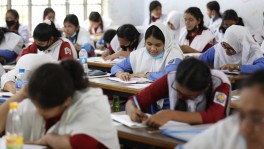'The supply-side approach may not fare well in an increasingly volatile economic environment'
A budget conversation with Dr Khondaker Golam Moazzem, Research Director, CPD

On Thursday, Finance Minister AHM Mustafa Kamal unveiled the proposed budget for the Fiscal Year 2021-22. The government claims the budget will create an investment-friendly environment and pave the way for economic recovery.
But is the budget really what the government says it is? Will it bring back the jobs? Or is it just another addition to a list of policies that cater only to the rich?
The TBS talked to Dr Khondaker Golam Moazzem, Research Director of the Centre for Policy Dialogue (CPD), to get a better insight into these questions.
In the budget for FY 2021-22, new tax cuts have been introduced instead of increased government investment in new or pre-existing projects. Do you think such policies will be fruitful in generating employment?
Given the uncertain circumstances posed by the Covid-19 pandemic, investors in the private sector are extremely cautious in terms of new investment. With private investors being risk-averse, it does not seem likely that they will invest in any new projects.
Under such disastrous circumstances, government investment in new projects plays a crucial role in generating employment. If you look at the US, the Biden Administration just introduced a $1.9 trillion relief package to stimulate aggregate demand and create a hospitable environment for increased investment from the private sector.
However, the government did allocate a significant portion (one-fifth of total ADP) to mega-development projects, much of which has been dedicated to generating electricity, i.e., the Rooppur Nuclear Power Plant and another significant portion has been allocated to infrastructural development in the transportation and communication sector, i.e., building new roads and bridges. Undoubtedly, these ventures will bring about increased investment and thereby create employment opportunities in the pertinent sectors.
But it is worth mentioning that many of the mega projects failed to utilise the allocated budget in the past financial year given pandemic-ridden uncertainties.
For example, these mega projects require foreign human resources, i.e., engineers, contractors etc. More often than not, they could not seamlessly participate in the projects because of the pandemic and the progress in these projects had been delayed. There is no certainty that similar circumstances will not be repeated in the upcoming fiscal year.
Secondly, it was not necessary to allocate such a significant portion of the ADP to these megaprojects. For example, 18,000 crores takas was allotted to the Rooppur Nuclear Power Plant, a project estimated to be completed by 2025. Interestingly, Bangladesh already has a surplus production of electricity. In fact, 48% of the existing electricity output remains unutilised.
Instead, the budget could prioritise sectors that could directly generate investment and employment. A higher share of the budget should have been allocated to the four ministries dedicated to employment generation (Their combined budget decreased by 10%). Projects like special economic zones (SEZs) or BSCIC industrial regions were nearing completion this year. These projects could have attracted investment and would generate employment but they did not receive a sufficient budget this year.
In summary, the supply-side approach undertaken by the government to boost investment may not fare well in an increasingly volatile economic environment where investors remain risk-averse and aggregate demand remains low. However, government investment coupled with an investment-friendly environment in the private sector has the potential to lift the economy in the short run.
Despite a rampaging pandemic, the allocation of budget to the health sector had actually decreased compared to last year. What do you think of such a stance of the government?
The health care sector in Bangladesh is a victim of long-term neglect. You can compare our health sector to a child suffering from malnutrition, and it would be unfair to expect the performance of a well-functioning adult from that child.
Given the Covid-19 pandemic, everyone seems to be well-aware of the significance of the health sector and the government appears to recognise that as well. However, the health sector does not have the infrastructures - skills, power and ability of the institutions - essential to sustain and utilize increased investment.
For instance, the health sector could only utilize 21% of the ADP budget allocated to it last year. If the sector could show more efficacy in tackling the Covid-19 crisis as well as efficiently utilising its resources, the scenario could have been a lot different.
The burden of this weakness falls on every person responsible within the Health Ministry. Despite having sufficient time (about 1.5 years) to develop the necessary infrastructure to tackle the pandemic, the health ministry failed miserably to do so. The very fact that the sector may not be able to overcome all of these contingencies in such a short period may just be the reason behind such low allocation of budget.
It also highlights inadequacy on the government's part and it should be aware of its failure to rectify the sector over the past year, especially after it was hit by the pandemic.
To be fair, there was some promising news coming out of the sector, particularly regarding vaccination, despite the scarcity of resources and inefficiency within the sector. And the government does warrant a round of applause for this achievement. However, the budget allocated for vaccines in the upcoming fiscal year appears to be insufficient to vaccinate 120 million citizens. It is not clear where the funding for the rest of the vaccines would come from.
Although the government pledged to treat the health care sector with utmost importance, its policies imply that there is a considerable mismatch between expectations and reality.
Furthermore, the government needs to develop the healthcare infrastructure to accommodate efficient vaccination, increase the availability of doctors, nurses and other health care professionals over the next year so that the health ministry appears equipped to utilise an increased budget efficiently during the next budget.
The government provided tax cuts to the businesses and increased the budget for megaprojects, while the marginalised communities, the youth, the returnee migrants did not receive sufficient budget. How do you view this decision from a policy position?
The introduction of any budget is a reflection of the political philosophy of the government. The government claims that the budget for FY 2021-22 will be an investment-friendly budget. The question remains whether the benefits accrued from this budget will reach the marginalised communities of the country.
These communities were already vulnerable to economic hardships induced by the Covid-19 pandemic. Recent natural disasters only deteriorated their condition.
For example, a lot of new households fell victim to poverty thanks to the Covid-19 pandemic. We expected the government to address their struggles in this budget and increase the budget for programmes like Work for Food or provide some form of stimulus to these households.
Unfortunately, the allocation actually decreased. While some may argue that social security was expanded under this budget, this increase could be principally attributed to an increase in the pension budget from 20,000 crores takas to 26,000 crores takas.
While the government argues that an investment-friendly environment would bring employment back to its natural level and increase the income for these households, that seems highly unlikely.
Small businesses are often called the backbone of the economy. Are tax cuts enough to save the struggling SMEs of the country? What other policies can be introduced?
Even though the government pampers SMEs as the backbone of the economy, their treatment of the sector leaves a lot to be desired. Since the outset of the pandemic, the economic growth of the country has been largely driven by large-scale industries instead of SMEs and CMSMEs.
The large industries received, among other benefits, stimulus from the government. Moreover, they also control a larger share of respective markets. Therefore, these companies could grow despite the disruptions in the supply chain as well as plummeting demand during the Covid-19 pandemic.
But the small and medium businesses kept losing money and they could not borrow any from typical creditors as they either lost confidence in the market or lost their capability to lend during the pandemic.
The government did address this issue partially by introducing 10-day tax holidays for agricultural enterprises with an investment of over TK1 crore. The government also introduced some benefits for the ICT sector and the small startups. SMEs in the IT sector would benefit from these.
However, it would be more potent if the investment threshold was brought down to somewhere around TK40 lacs as it would allow more small and medium enterprises to benefit from these packages.
Furthermore, tax exemption or reduction would only partially mitigate the issues facing these farms as it does not address the debilitating cash and credit crunch. On top of that, the first round of stimulus packages only included a fraction of the firms and that too remained underutilised. A second round of stimulus package worth TK20,000-30,000 crores should be introduced and should prioritise SMEs over large industries.
Other than that, low-interest credit support should be extended to SMEs through the financial institutions as well as NGOs and credit associations to take care of the existing credit crunch. The central bank can also provide guidelines for the private banks requiring that at least 30% of the people receiving the loans are new borrowers. The loan payback period should be extended as well, so that firms can first utilise the loans to improve their condition and then pay their dues.


 Keep updated, follow The Business Standard's Google news channel
Keep updated, follow The Business Standard's Google news channel
















